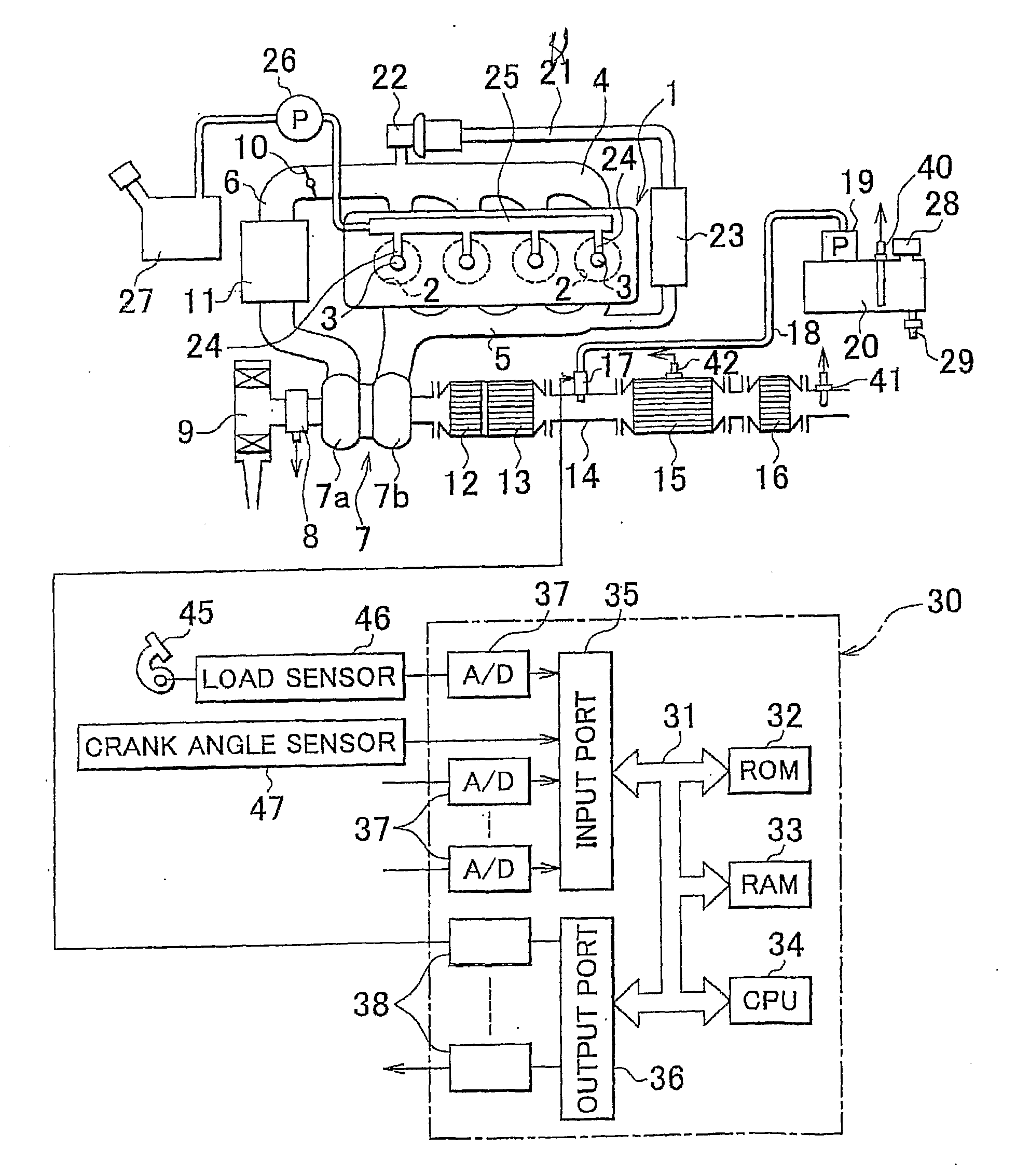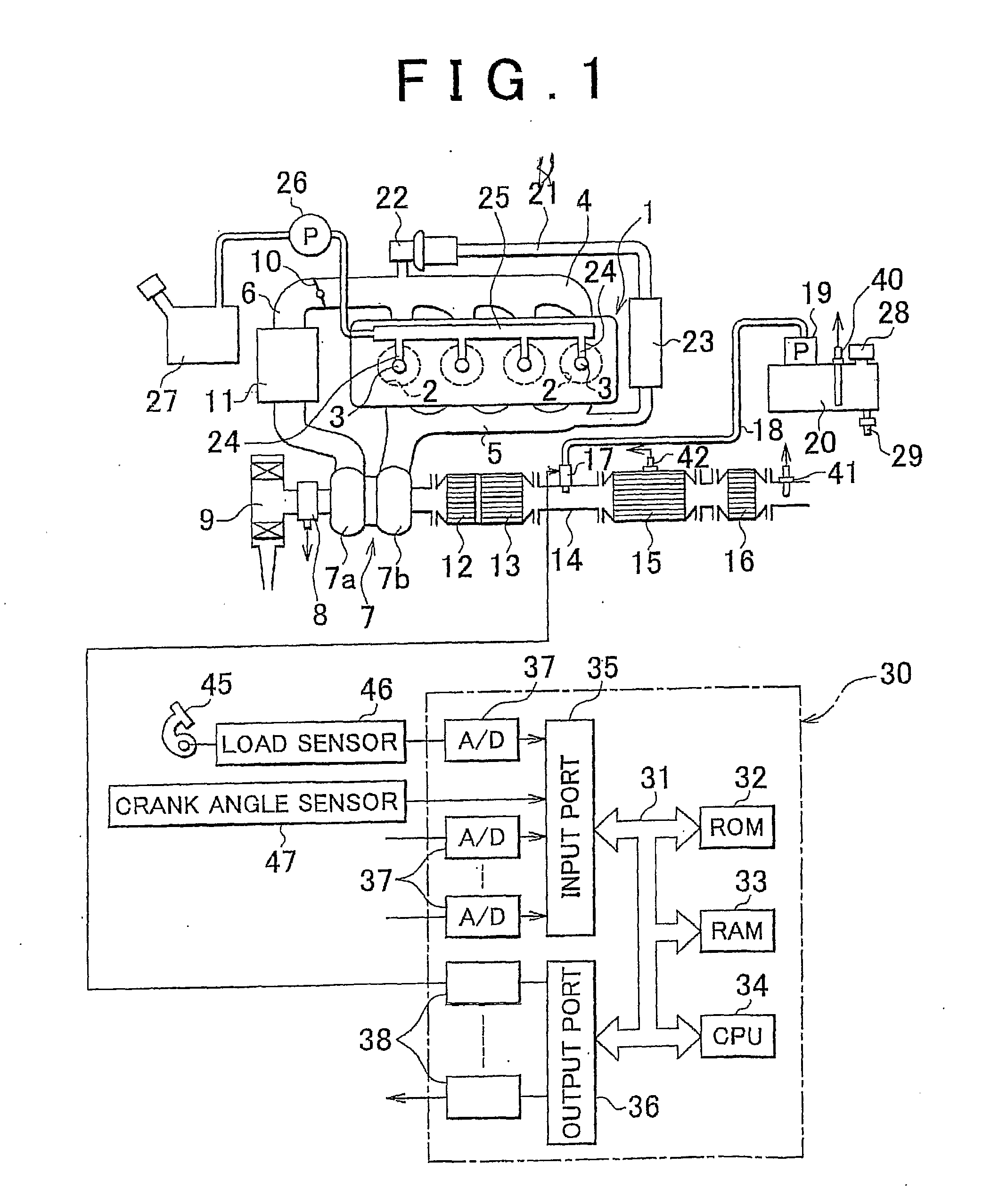Exhaust emission control system of internal combustion engine and exhaust emission control method
an emission control system and internal combustion engine technology, applied in the direction of electrical control, exhaust treatment electric control, separation process, etc., can solve the problem of high cost of urea concentration sensor, and achieve the effect of reducing cos
- Summary
- Abstract
- Description
- Claims
- Application Information
AI Technical Summary
Benefits of technology
Problems solved by technology
Method used
Image
Examples
second embodiment
[0054]Thus, in the present invention as described below, it is determined by use of the level sensor 40 whether a supplementary liquid has been supplied into the aqueous-urea tank 20 for refilling. If it is determined that the supplementary liquid has been supplied into the aqueous-urea tank 20, and the NOx conversion efficiency detected after the supply of the supplementary liquid becomes lower than a predetermined permissible level, the concentration of aqueous urea in the aqueous-urea tank 20 is estimated from the detected NOx conversion efficiency.
[0055]In the second embodiment of the invention, if it is determined that the supplementary liquid has been supplied to the aqueous-urea tank 20, and the NOx conversion efficiency detected after the supply of the supplementary liquid is lower than the predetermined permissible level, an abnormal condition in which the concentration of aqueous urea in the aqueous-urea tank 20 is abnormally reduced is presumed to be established.
[0056]FIG...
third embodiment
[0065]In the third embodiment, assuming that the supplementary liquid added or supplied into the aqueous-urea tank 20 is a liquid whose ammonia concentration is equal to zero, the concentration of aqueous urea in the aqueous-urea tank 20 after the supply of the supplementary liquid is calculated based on the above assumption. The assumed concentration of aqueous urea is used for preventing the concentration of aqueous urea from being erroneously recognized as being reduced even though the concentration of aqueous urea is not actually reduced.
[0066]Supposing a Qa amount of supplementary liquid is supplied into the aqueous-urea tank 20 when a Qr amount of aqueous urea remains in the tank 20, as shown in FIG. 10A, the amount of aqueous urea in the aqueous-urea tank 20 increases from Qr to (Qr+Qa), as shown in FIG. 10B. Assuming that a supplementary liquid whose ammonia concentration is equal to zero is used as the supplementary liquid supplied to the aqueous-urea tank 20, which is a wo...
fourth embodiment
[0077]In the invention, therefore, a NOx conversion efficiency used for estimating the aqueous-urea concentration, which does not involve a reduction in the detected NOx conversion efficiency due to deterioration of the NOx sensor 41, is obtained from the detected NOx conversion efficiency detected by the NOx sensor 41, and a NOx conversion efficiency used for estimating the aqueous-urea concentration, which does not involve a reduction in the detected NOx conversion efficiency due to deterioration of the NOx selective reduction catalyst 15, is obtained from the detected NOx conversion efficiency detected by the NOx sensor 41, while a NOx conversion efficiency used for estimating the aqueous-urea concentration, which does not involve a reduction in the NOx conversion efficiency due to the defect of the aqueous-urea supply valve 17, is obtained from the detected NOx conversion efficiency detected by the NOx sensor 41. Then, the concentration of aqueous urea in the aqueous-urea tank 2...
PUM
| Property | Measurement | Unit |
|---|---|---|
| concentration | aaaaa | aaaaa |
| liquid level | aaaaa | aaaaa |
| RA | aaaaa | aaaaa |
Abstract
Description
Claims
Application Information
 Login to View More
Login to View More - R&D
- Intellectual Property
- Life Sciences
- Materials
- Tech Scout
- Unparalleled Data Quality
- Higher Quality Content
- 60% Fewer Hallucinations
Browse by: Latest US Patents, China's latest patents, Technical Efficacy Thesaurus, Application Domain, Technology Topic, Popular Technical Reports.
© 2025 PatSnap. All rights reserved.Legal|Privacy policy|Modern Slavery Act Transparency Statement|Sitemap|About US| Contact US: help@patsnap.com



